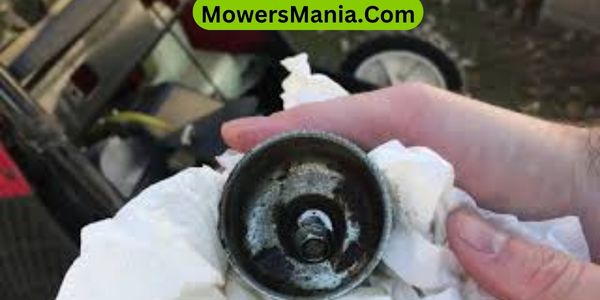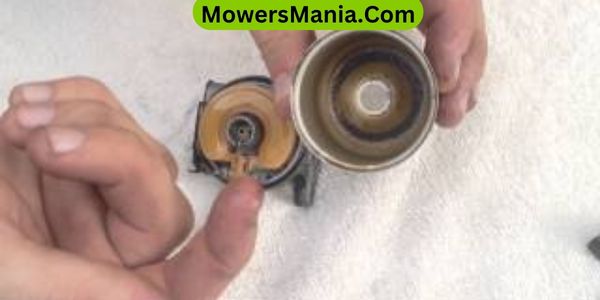Hey, you want your mower to run smoothly, right? Cleaning the carburetor is essential for keeping it in top shape.
But, you want to do it safely. So, what’s the safest way to clean a mower carburetor? Let’s walk through the process step by step to make sure you do it right and stay safe.

Safety Precautions
Before you start cleaning the mower carburetor, make sure to take necessary safety precautions to protect yourself from any potential hazards.
First, ensure that the engine is turned off and cool to the touch. You don’t want to risk burns or other injuries from hot engine parts.
Next, disconnect the spark plug wire to prevent accidental starting of the engine while you work on the carburetor. It’s also important to work in a well-ventilated area to avoid inhaling any fumes or gases that may be emitted during the cleaning process.
Wearing safety goggles is crucial to shield your eyes from any debris or chemicals that may splash during the cleaning. Additionally, using gloves can protect your hands from sharp edges or any harsh cleaning solutions.
When handling cleaning solvents or chemicals, make sure to read and follow the manufacturer’s instructions and warnings carefully to prevent any adverse reactions or accidents.
Lastly, keep a fire extinguisher nearby, especially if you’re working with flammable cleaning agents. It’s better to be prepared for any potential emergencies.
By following these safety precautions, you can ensure a safer cleaning process for your mower carburetor.
Tools and Materials Needed
You will need a set of basic hand tools and a carburetor cleaner to effectively clean a mower carburetor.
Here’s a list of the tools and materials required for this task:
| Tools | Materials | Additional Items |
|---|---|---|
| Screwdriver | Carburetor cleaner | Work gloves |
| Socket wrench | Wire brush | Safety goggles |
| Pliers | Compressed air | Drip pan or tray |
| Carburetor adjustment tool | Shop rags |
The screwdriver and socket wrench will be useful for removing the screws and bolts holding the carburetor in place.
Pliers will come in handy for disconnecting any fuel lines or linkages. The carburetor cleaner is essential for removing built-up gunk and debris from the carburetor parts. A wire brush and compressed air will help in cleaning hard-to-reach areas and small passages.
Additionally, using a carburetor adjustment tool may be necessary for fine-tuning the carburetor after cleaning. Don’t forget to wear work gloves and safety goggles to protect yourself from any chemicals or debris during the cleaning process.
Lastly, having a drip pan or tray to catch any spills and shop rags for cleanup will make the job much easier.
Removing the Carburetor

To remove the carburetor, follow these steps:
- Locate the screws and bolts holding it in place using a socket wrench or screwdriver.
- Carefully loosen and remove these fasteners, keeping track of each one for reassembly.
- Gently disconnect any linkages, fuel lines, or other connections attached to the carburetor, noting their placement and orientation.
- Once all necessary components are disconnected, carefully lift the carburetor out of its position.
- Be mindful of any gaskets or seals that may come loose during this process.
- Inspect the carburetor and surrounding areas for damage or wear that may need to be addressed during cleaning.
- With the carburetor removed, proceed with the cleaning process, following the manufacturer’s instructions and using appropriate cleaning solutions.
- Handle the carburetor with care to avoid causing any damage that may affect its performance.
Cleaning the Carburetor Components
Start by carefully disassembling the carburetor, ensuring you keep track of each component’s placement and orientation.
Remove the screws or bolts holding the carburetor together and gently take it apart. Lay out the components in the order you remove them, making note of their positions.
Once the carburetor is disassembled, visually inspect each component for any signs of damage, corrosion, or blockages.
Use a carburetor cleaner specifically designed for this task to clean the components thoroughly. Pay close attention to the small passages and jets, ensuring they’re completely free of any debris or residue.
A small wire or brush can be used to carefully clean these areas. Be cautious not to damage any delicate parts during the cleaning process.
After cleaning, allow the components to air dry completely before reassembling the carburetor. Take your time to ensure that each part is reinstalled in the correct order and position.
Once reassembled, the carburetor should be ready to be installed back onto the mower.
Reassembling and Testing the Carburetor

After cleaning and thoroughly inspecting the components of the carburetor, carefully reassemble the carburetor, ensuring each part is placed in its correct position and orientation.
Start by placing the diaphragm and gasket onto the carburetor body, followed by the metering lever and spring.
Then, carefully position the float and needle valve, ensuring that they move freely without any obstruction.
Next, attach the float bowl and secure it with the appropriate screws, making sure it’s tightly sealed.
Reattach the primer bulb, fuel lines, and air filter housing, ensuring that they’re all properly connected and secured.
Once reassembled, it’s crucial to test the carburetor to ensure it functions correctly.
Reconnect the fuel supply and start the engine, allowing it to run for a few minutes to check for any leaks, irregularities, or rough idling.
Adjust the idle and mixture screws as needed to achieve smooth operation.
Finally, conduct a throttle response test to ensure the carburetor is functioning optimally.
Following these steps will help ensure the safe and effective reassembly and testing of the mower carburetor.
Frequently Asked Questions [FAQs]
Can I Clean a Mower Carburetor Without Removing It From the Mower?
You can clean a mower carburetor without removing it, but it’s safer to take it out for a thorough cleaning. Disconnect the fuel line, remove the carburetor, and use a carburetor cleaner to ensure a proper cleaning.
How Often Should I Clean My Mower Carburetor?
You should clean your mower carburetor at least once a year to prevent build-up and ensure optimal engine performance. Regular maintenance helps avoid costly repairs and extends the life of your mower.
Is It Safe to Use Compressed Air to Clean the Carburetor Components?
Yes, it’s safe to use compressed air to clean the carburetor components, but make sure to wear eye protection and work in a well-ventilated area. Use short, controlled bursts of air to avoid damaging the components.
Can I Use Any Type of Cleaner to Clean the Carburetor Components?
You can’t use just any cleaner for carburetor components. Use a specialized carburetor cleaner to avoid damaging sensitive parts. Always work in a well-ventilated area and follow safety precautions on the cleaner’s label.
What Should I Do if I Notice Any Damage to the Carburetor Components While Cleaning?
If you notice any damage to the carburetor components while cleaning, stop immediately. Carefully assess the damage and consider consulting a professional if needed. It’s important to ensure the carburetor is in good working condition for optimal mower performance.
Conclusion
Now that you have cleaned your mower carburetor, remember to always follow safety precautions and use the right tools for the job.
Regular maintenance and cleaning will keep your mower running smoothly and efficiently.
Keep an eye on your carburetor and address any issues promptly to ensure a safe and effective mowing experience.
Happy mowing!



